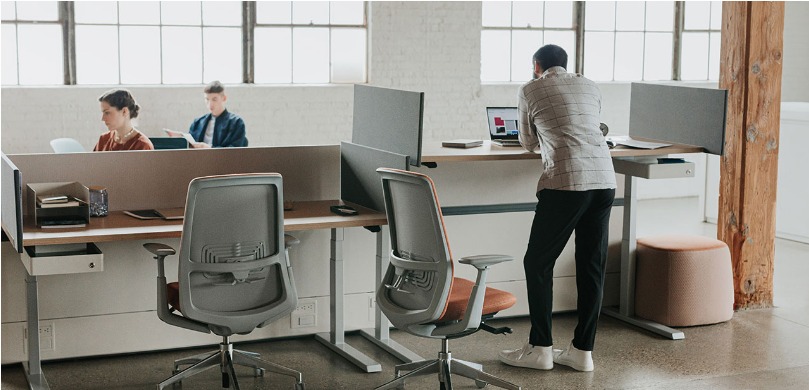Technologies that enable flexible work locations and schedules have been critical to helping companies, schools, and communities stay connected during the COVID-19 outbreak. Yet, regardless of where or when we're working, our reliance on technology has created a more sedentary work experience. On average, today's office workers are more inactive than ever before. Continue reading to learn about the three layers of movement and how they can enhance employees' overall work experience and well-being.

So, how do we create a work experience that nurtures well-being? A simple step that companies can start with is encouraging movement. Movement can help boost an individual’s well-being, and, in turn, lead to a boost in performance.
What are the 3 Layers of Movement?.jpeg?width=600&height=287&name=3%20layers%20of%20movement%20blog%20image%202%20(1).jpeg)
To understand more, Haworth partnered with Michigan State University to study and identify the three layers of movement:
1. Posture
Posture involves training your body to sit, stand, walk, and lie in positions where the least strain is placed on supporting muscles and ligaments. Good posture helps apply the appropriate amounts of pressure on our joints and ligaments by maintaining the correct amount of muscle tension. Posture is not limited to the muscles in your back—everything, from your neck to your abdominal muscles—and even your hamstrings, plays a key role in maintaining the correct postural alignment of the body.
2. Position
Position change involves moving from seated to standing or vice versa. It’s a significant shift in the body’s weight distribution. Position change helps improve blood circulation, reduces swelling, and enhances musculoskeletal comfort.
3. Location
Location involves walking or moving to a different place. Changing location stimulates cognition, creates opportunities for connections with others, and reduces the potential for musculoskeletal disorders associated with long-term static postures.
The Key to Each Layer of Movement is Change & Here’s Why:
Many of us are familiar with the challenges of long-term sitting. However, long periods of standing place an additional load on the circulatory system, which can cause joint compression, increase the risk of varicose veins, and lead to foot or leg swelling.
Each of the three layers of movement adds value to a person’s overall well-being. Every movement matters. There is increasing recognition that even low-intensity physical activity plays a vital role in positive well-being. Some people refer to posture change in your chair as fidgeting. But fidgeting is actually good for us! It expends 35% more energy than simply sitting and 28% more energy than simply standing alone.
.jpeg?width=311&height=460&name=zody%20ii-xl%20image%202%20(1).jpeg) Made to Move
Made to Move
Ultimately, the best posture, position, or location is the next one. As human beings, we're made to move, and our well-being benefits when we fuel it with movement.
Organizations benefit when people move too. According to the American Heart Association, organizations that create a culture of movement can increase productivity, reduce absenteeism, experience lower turnover, and reduce healthcare costs.
Ready to make your next move? See how your organization can benefit from Haworth’s extensive and diverse portfolio of office furniture, including the new industry-first, movement-centric Zody II and Zody LX Task Chairs, available to public agencies on a cooperative contract through OMNIA Partners.

.jpeg?width=600&height=287&name=3%20layers%20of%20movement%20blog%20image%202%20(1).jpeg)
.jpeg?width=311&height=460&name=zody%20ii-xl%20image%202%20(1).jpeg)